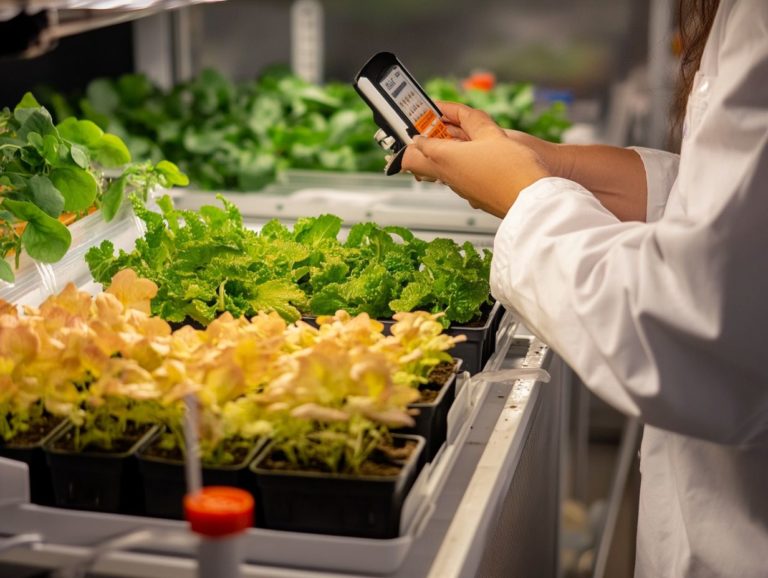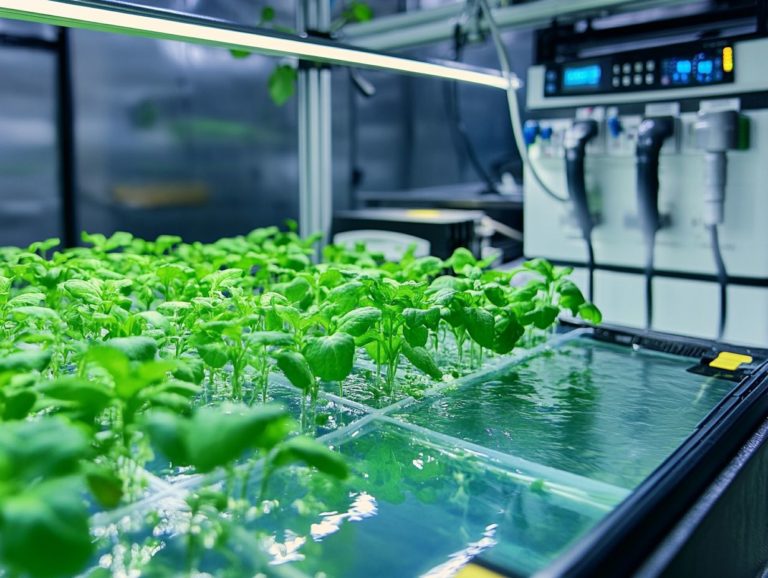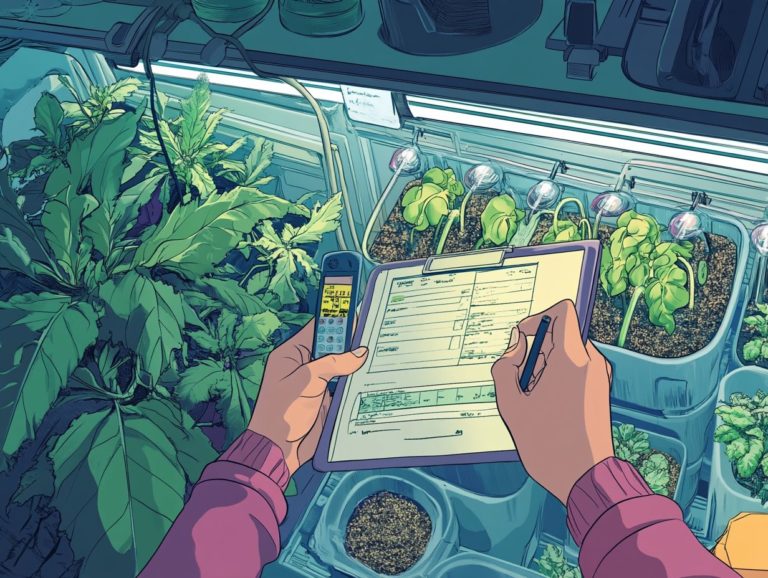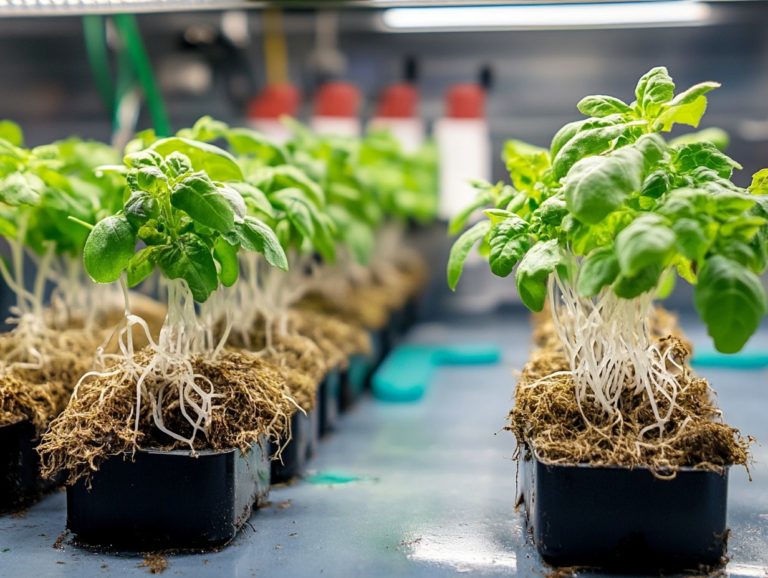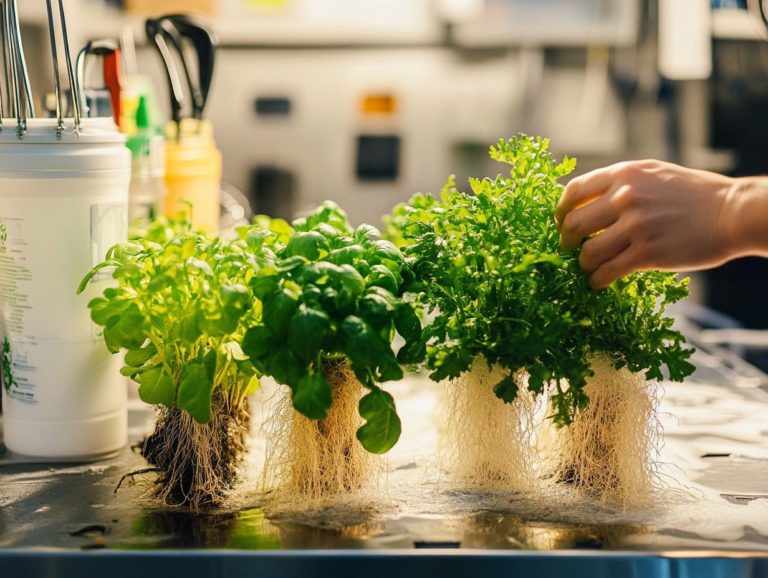Understanding the Hydroponic Nutrient Cycle
In the realm of hydroponics, mastering the nutrient cycle is crucial for your plants to thrive. Without soil, your plants depend on a meticulously balanced mix of nutrients to grow, flourish, and yield abundantly.
This article delves into the importance of nutrients within hydroponic systems, unpacking their roles at every stage of growth from germination to harvest.
You ll find insightful guidance on managing nutrient levels and tackling common deficiencies, empowering your hydroponic garden to reach its fullest potential.
Jump in now to discover the secrets to thriving plants in hydroponic gardening!
Contents
- Key Takeaways:
- Importance of Nutrients in Hydroponic Systems
- The Four Stages of Hydroponic Nutrient Cycle
- Managing Nutrient Levels in Hydroponic Systems
- Common Nutrient Deficiencies and How to Address Them
- Frequently Asked Questions
- What is the hydroponic nutrient cycle and its importance in maximizing hydroponics benefits?
- How does the hydroponic nutrient cycle work and how does it improve nutrient absorption?
- Why is understanding the hydroponic nutrient cycle important for ensuring nutrient balance?
- What are the essential nutrients in hydroponics?
- Can I reuse the nutrient solution in the hydroponic nutrient cycle and what are the nutrient requirements?
- What are the benefits of the hydroponic nutrient cycle in improving nutrient efficiency?
Key Takeaways:
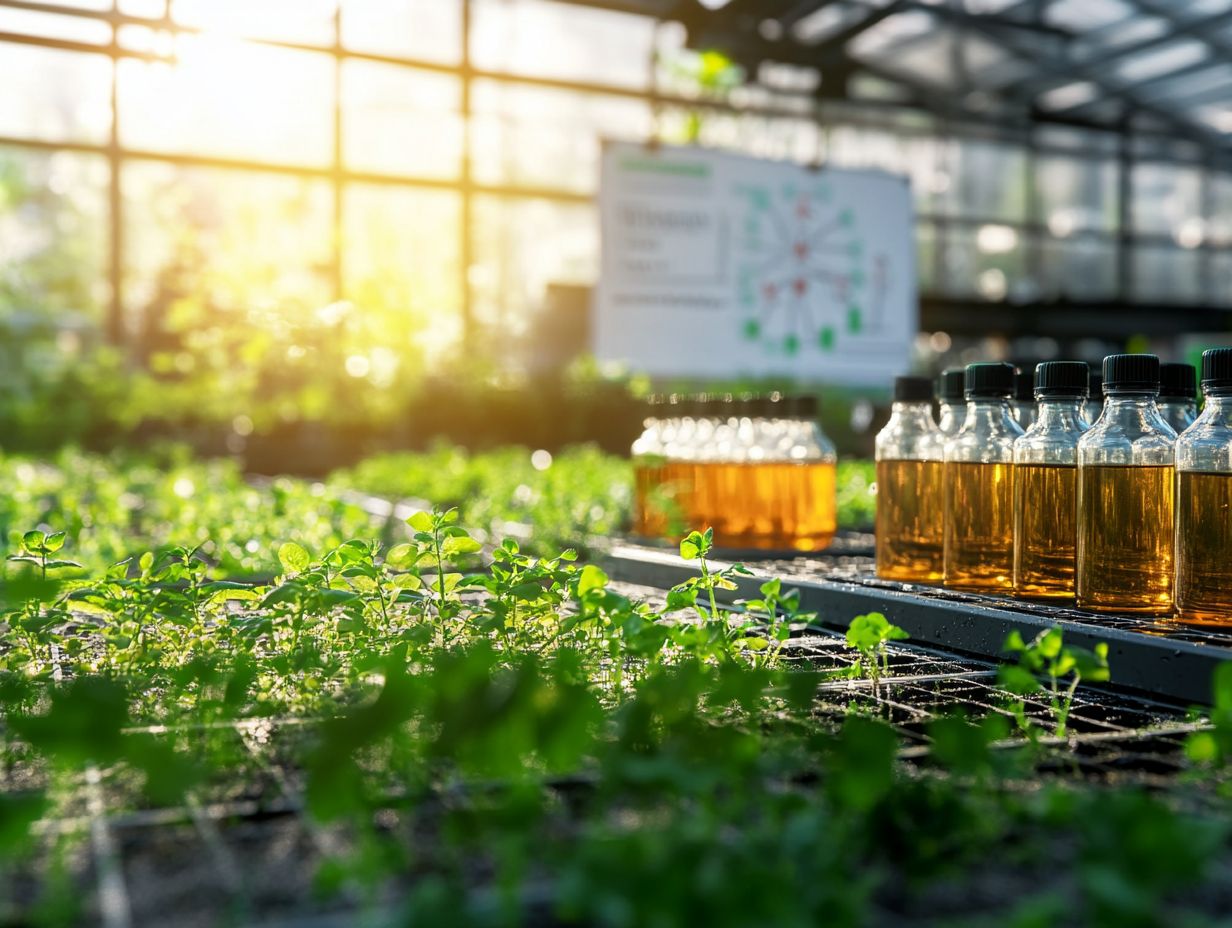
- Understanding the hydroponic nutrient cycle is essential for successful plant growth in hydroponic systems.
- Nutrients play a vital role in the growth and development of plants in hydroponic systems, and different nutrient types have specific functions.
- Monitoring and adjusting nutrient levels and addressing common deficiencies are crucial for maintaining a healthy hydroponic nutrient cycle.
What is Hydroponic Nutrient Cycle?
The hydroponic nutrient cycle is an essential process that ensures you provide plants with the vital nutrients they need for optimal growth without a hint of soil. In hydroponic systems, nutrient solutions go straight to the roots, granting you precise control over nutrient availability and concentration.
This cycle includes mixing, taking in, and adjusting both macronutrients and micronutrients, such as nitrogen, phosphorus, potassium, calcium, magnesium, and sulfur, each critical at different growth stages and for preventing nutrient deficiencies. For a deeper insight, you can refer to understanding the nutrient cycle in hydroponics.
In the nutrient preparation phase, you mix water with macronutrients and micronutrients to create a balanced solution tailored to the specific needs of your plants. The macronutrients nitrogen for lush foliage, phosphorus for robust root development, and potassium for overall plant health are crucial for thriving growth. Micronutrients, though required in smaller amounts, play essential roles in processes like photosynthesis and enzyme activity.
When compared to traditional soil gardening, hydroponics offers a more efficient nutrient uptake, minimizes the risk of soil-borne diseases, and conserves water. This makes it a sustainable and controlled alternative for cultivating a vast array of plants in diverse environments.
Importance of Nutrients in Hydroponic Systems
Nutrients are essential in hydroponic systems, serving as the cornerstone for vibrant plant growth and development. In the absence of soil, managing nutrient levels with precision becomes paramount, as your plants depend entirely on the nutrient solution for their macronutrient and micronutrient needs.
Striking the right nutrient balance is crucial. It fosters chlorophyll production, supports proper growth stages, and enhances overall plant health. This careful balance prevents nutrient deficiencies, which can hinder growth and lower yield.
Role of Nutrients in Plant Growth
Nutrients are absolutely essential for your plants’ growth, as they drive vital processes like chlorophyll production and nutrient absorption, directly impacting overall development in hydroponic gardening. Each type of nutrient has its own specific role: nitrogen, for instance, is key for promoting lush leaf growth, while phosphorus encourages robust root development and flowering, and potassium boosts overall plant vitality.
These macronutrients work in harmony with micronutrients, such as manganese and zinc. Although required in smaller amounts, these micronutrients are critical for numerous biochemical pathways that support plant health. They play a crucial role in enzyme activation and chlorophyll synthesis, enabling your plants to efficiently convert sunlight into energy.
As your plants progress through various growth stages, the interplay between these nutrients becomes even more significant. For example, during the vegetative stage, maintaining a balanced supply of nitrogen and potassium is vital for maximizing leaf area and photosynthesis, establishing a solid foundation for the flowering phase.
By grasping the comprehensive roles of both macronutrients and micronutrients, you can foster healthier, more productive plants in your hydroponic system.
Types of Nutrients and Their Functions
In hydroponics, nutrients are divided into macronutrients and micronutrients. Each plays a vital role in healthy plant growth. Macronutrients include nitrogen, phosphorus, potassium, calcium, magnesium, and sulfur. These are needed in larger quantities. Micronutrients, such as zinc and iron, are required in trace amounts to support key functions like enzyme activities and photosynthesis.
Understanding the specific roles of these nutrients is crucial for optimizing your plants’ health. For example, nitrogen fuels robust leaf growth. Phosphorus is essential for root development and flowering, while potassium enhances overall plant resilience.
Common sources of these nutrients include various fertilizers and naturally occurring minerals. Don t let a deficiency in any macronutrient slow down your plants growth; it could lead to stunted growth or disappointing yields. Similarly, insufficient micronutrients can cause issues like chlorosis or other metabolic disorders.
To keep your hydroponic system thriving, keep a close eye on your nutrient levels. Adjust your solutions as needed to ensure both macronutrients and micronutrients are available for flourishing plants.
The Four Stages of Hydroponic Nutrient Cycle
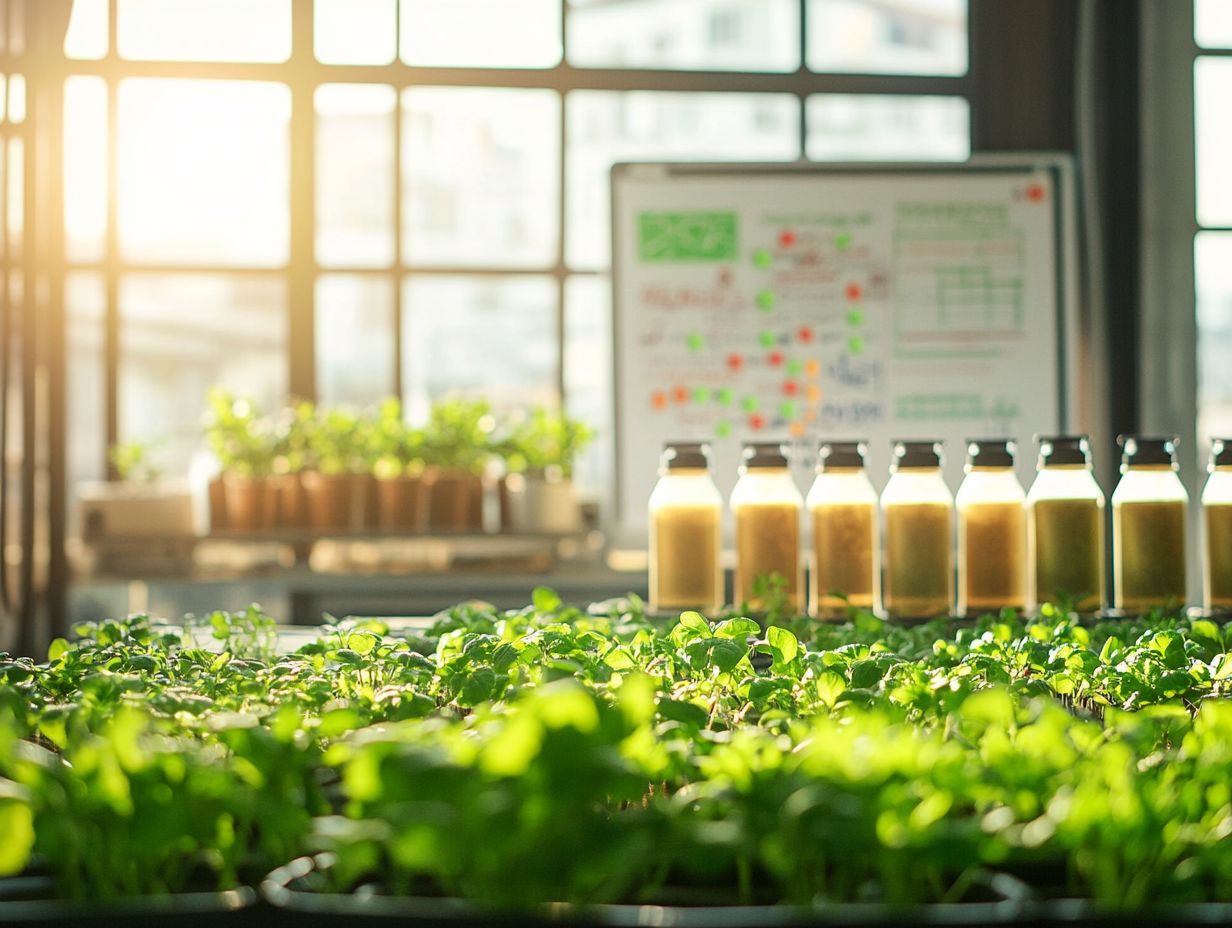
The hydroponic nutrient cycle has four essential stages that match the growth phases of your plants. This alignment ensures that nutrient availability and composition are tailored to meet their specific needs at every stage.
These stages are germination and seedling, growth, flowering and fruiting, and harvest and replenishment. Each phase requires careful preparation and adjustment of your nutrient solution to enhance nutrient absorption and promote healthy plant growth.
Germination and Seedling Stage
In the germination and seedling stage, young plants thrive on a nutrient solution packed with essential elements. This support is crucial for their early growth. It s wise to use a balanced nutrient mix with lower concentrations to facilitate proper nutrient absorption and prevent potential issues.
To achieve optimal results, monitor specific nutrient concentrations. Focus on nitrogen, phosphorus, and potassium, as these are vital for early plant development. Aim for nitrogen at around 50-100 ppm, while phosphorus and potassium can range from 20-40 ppm, depending on the species.
Maintaining a pH level between 5.5 and 6.5 is crucial. This range ensures that nutrients remain available for plants to use, allowing seedlings to absorb them efficiently. Use techniques like regular nutrient solution testing and adjust based on observed plant health. This can enhance the effectiveness of your practices, leading to strong and vigorous growth during this critical stage.
Growth Stage
In the growth stage, you’ll notice your plants undergoing rapid development. They need a nutrient solution rich in macronutrients to meet their increasing demands. Ensuring a precise nutrient balance during this crucial phase is vital for maximizing nutrient absorption and promoting robust plant growth.
Provide adequate nitrogen, phosphorus, and potassium, as these macronutrients are fundamental for energy production and structural integrity. Don t overlook the importance of micronutrients like iron, magnesium, and calcium; these are important for enzyme function and chlorophyll synthesis, both critical for healthy photosynthesis.
Monitoring your nutrient solution is essential. Regularly test the pH and electrical conductivity to maintain optimal levels. Adjust as necessary to meet the specific growth needs of your plants. This careful balance fosters vigorous growth and significantly boosts overall plant health, ultimately leading to higher yields.
Flowering and Fruiting Stage
The flowering and fruiting stage is a pivotal moment in your hydroponic nutrient cycle. During this phase, your plants require more nutrients to support the development of blooms and fruit.
It’s essential to fine-tune your nutrient solution. Enrich it with potassium and phosphorus to encourage robust blossoms and fruitful yields while preventing deficiencies that could impact your harvest.
Maintain a balanced ratio of nitrogen, but at a reduced level. This shift allows energy to focus on flower development rather than excessive foliage growth.
Typically, a nutrient formulation featuring a higher concentration of potassium, often in a 4:1:2 (N:P:K) ratio, works beautifully.
Regularly monitoring your nutrient levels is crucial. Keeping an eye on EC a measure of how well the solution conducts electricity and pH will help you avoid any spikes or drops that could hinder your plants’ progress.
By giving meticulous attention to nutrient balance, you optimize your yield and elevate the quality and flavor of your produce.
Harvest and Replenishment Stage
The harvest and replenishment stage isn t just about gathering the yield; it also involves preparing the nutrient solution for the next crop cycle.
After the harvest, conduct nutrient testing to analyze residual nutrient levels in the system. This step is crucial for optimizing nutrient preparation for your next planting.
Ensure that your new plants receive the ideal nutrient mix right from the start.
To manage nutrients effectively during this stage, adopt best practices. Regularly testing nutrient solutions using reliable methods will reveal specific elements that need adjustment.
Taking a systematic approach allows you to formulate nutrient solutions tailored to the upcoming crops needs, promoting their healthy growth.
Keep your hydroponic system clean and efficient. This not only helps prevent diseases but also enhances nutrient availability while minimizing waste.
Regularly flushing the system and inspecting its components will help you achieve optimal performance throughout the growth cycle.
Managing Nutrient Levels in Hydroponic Systems
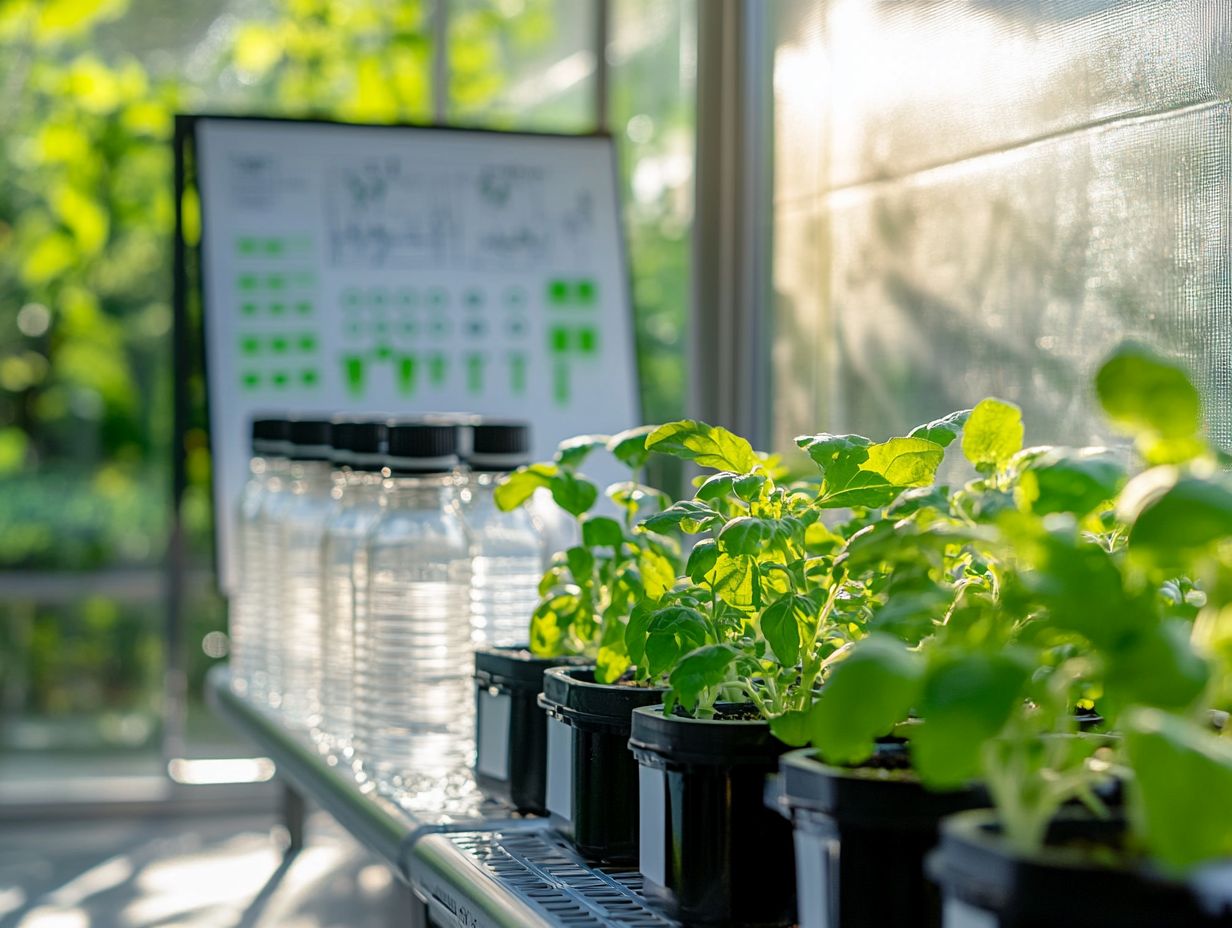
Effectively managing nutrient levels in hydroponic systems is crucial for ensuring the health of your plants and maximizing yield.
By regularly monitoring nutrient concentrations, pH levels, and overall nutrient balance, you empower yourself to make timely adjustments to the nutrient solution.
This proactive approach optimizes nutrient absorption and prevents potential deficiencies that could impede plant growth.
Monitoring and Adjusting Nutrient Levels
Monitoring and adjusting nutrient levels is a cornerstone of hydroponic gardening. It directly impacts plant health and growth efficiency.
By regularly testing the nutrient composition of your solution, you can pinpoint any problems or imbalances.
This allows you to make essential adjustments that ensure optimal nutrient availability for your plants.
You can also use tools like EC meters and pH testers. These tools provide immediate feedback on the strength and acidity of your nutrient solution.
Soil testing kits and specialized mobile applications for agricultural analysis can offer valuable insights into the specific needs of various plants throughout their growth stages.
Understanding that nutrient requirements shift from germination to flowering is vital. This means adjustments in your nutrient mix are necessary.
For example, a higher nitrogen concentration is often beneficial during the vegetative phase, while increased phosphorus and potassium levels promote blooming.
By thoughtfully implementing these strategies, you can nurture robust and thriving crops in your hydroponic garden.
Take charge of your hydroponic garden today and watch your plants thrive!
Common Nutrient Deficiencies and How to Address Them
Common nutrient deficiencies can present serious challenges for hydroponic growers, often resulting in stunted plant growth and diminished yields. Recognizing these deficiencies early is essential. It allows you to mitigate their impacts and take corrective action.
By ensuring your plants receive the necessary nutrients, you’ll promote optimal health and growth, paving the way for a thriving hydroponic system.
Spotting Nutrient Problems and Fixing Them
Identifying and addressing nutrient deficiencies in hydroponic systems is crucial for helping plants grow strong and maximizing your yield. Keep an eye out for signs like discoloration, stunted growth, or leaf drop. This can help you pinpoint specific deficiencies related to essential nutrients such as nitrogen, phosphorus, and potassium, as well as calcium and magnesium.
For instance, if you notice yellowing in older leaves, it could signal a nitrogen deficiency. A touch of purple hues might hint at a lack of phosphorus. If you encounter browning leaf edges and curling foliage, those could be signs of potassium deficits.
By recognizing these visual cues, you can make the necessary adjustments to your nutrient solutions. Ensure your plants receive the optimal balance of essential elements.
You can implement solutions like incorporating targeted fertilizers or fine-tuning pH levels to effectively address these deficiencies. This ultimately boosts your plants’ vigor and productivity.
Watch this video to learn more about nutrient deficiencies:
Frequently Asked Questions
What is the hydroponic nutrient cycle and its importance in maximizing hydroponics benefits?
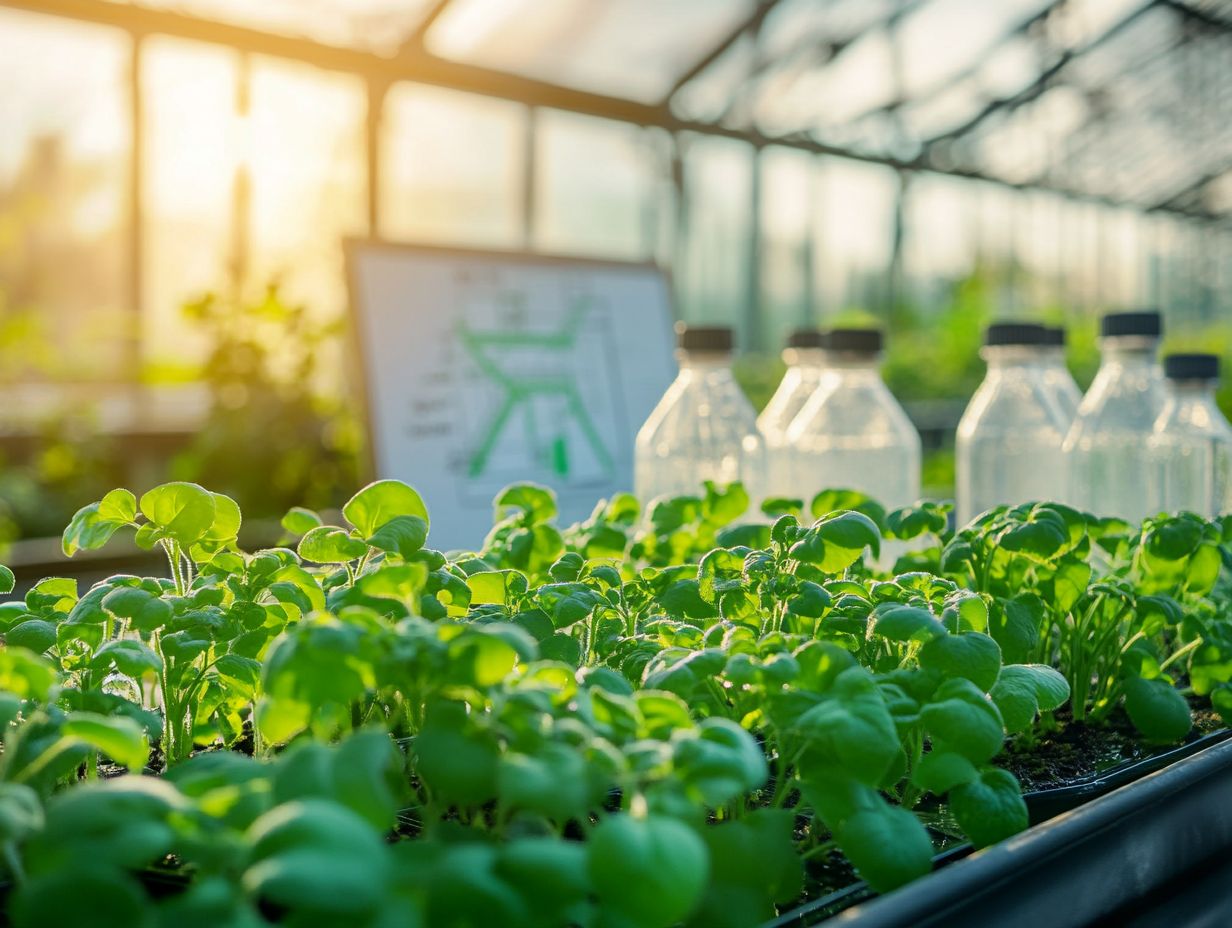
The hydroponic nutrient cycle is the process of supplying plants with essential nutrients in a soilless growing system. It involves providing the plants with the necessary nutrients through a water-based solution that is continuously cycled through the system.
How does the hydroponic nutrient cycle work and how does it improve nutrient absorption?
The hydroponic nutrient cycle works by providing the plants with all the necessary nutrients they need through a water-based solution. The solution is circulated through the system, providing the plants with a continuous supply of nutrients. The plants absorb the nutrients through their roots, and any excess solution is drained and recycled back into the system.
Why is understanding the hydroponic nutrient cycle important for ensuring nutrient balance?
Understanding the hydroponic nutrient cycle is crucial to ensure that plants receive the proper nutrients they need to grow and thrive in a soilless system. This knowledge allows growers to adjust and monitor the nutrient levels, preventing deficiencies or excess that can harm the plants and impact their photosynthesis.
What are the essential nutrients in hydroponics?
The essential nutrients in the hydroponic nutrient cycle include nitrogen, phosphorus, potassium, calcium, magnesium, sulfur, zinc, and iron. These nutrients are necessary for plant growth and development. They are typically provided through a balanced nutrient solution that supports effective nutrient absorption.
Can I reuse the nutrient solution in the hydroponic nutrient cycle and what are the nutrient requirements?
Yes, you can reuse the nutrient solution in the hydroponic nutrient cycle. However, it is essential to monitor and adjust the nutrient levels regularly. The plants will absorb certain nutrients more quickly than others. The solution should also be changed periodically to prevent any buildup of harmful salts, ensuring nutrient availability.
What are the benefits of the hydroponic nutrient cycle in improving nutrient efficiency?
The hydroponic nutrient cycle has several benefits, including faster growth rates, higher yields, and the ability to control and monitor nutrient levels for optimal plant growth. It also eliminates the need for soil, making it a cleaner and more sustainable option for growing plants.
Ready to optimize your hydroponic system? Start implementing these tips today!

